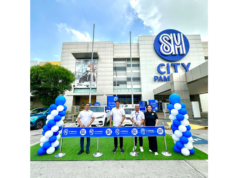CABANATUAN CITY- Dull and going duller as times wear on.
This is the common observation here by concerned individuals as officials concerned seemed not bent on giving much importance to historical, cultural other events worthy of appreciation in Nueva Ecija.
“Agreed,” said Reynato Arimbuyutan, co-chair of the regional development council in Region III, in one of the regular airings of the “Forum ng Bayan,” a radio program over Station DWAY Sonshine Radio here.
It needs sharpening, he acknowledged, but added that he would push for the establishment of a “Nueva Ecija Center for Studies” here. It will not only “sharpen the sense for the rightful recall and commemoration of the significant events played by the province but will also look after historical markers commonly victimized by vandals, and the proper projection of the province in other aspects.”
Arimbuyutan’s comment was made during the early days of the month-long observance of “Heroes Month” this August. In a proclamation, then Pres. Noynoy Aquino emphasized that the “most significant turning points in Philippine history” happened in August.
Two events in Nueva Ecija need sharper focus on meaningful observance.
On the last days of August, Nueva Ecija revolutionists made a bold decision to rise up against the Spanish oppression. Thus, on Sept 2, 1896, about 3,000 of them massed in the village of Pulo in Cabiao town (about five kilometers from San San Isidro, then the capital of the province) to start the attack. Wearing red ribbons, led by a musikong bumbong from Cabiao and Gen. Mariano Llanera, one of the leaders of the revolution, they “duped” the Spanish officials and guardia civil by pretending to observing a celebration.
Only 500 were selected to join the flamboyant attacks, though, as they only had 100 rifles. The others bore spears, bolos and pointed bamboo poles only. They floated the idea that they will serenade the governor to free the jailed revolutionists then.
Llanera who was then the gobernadorcillo of Cabiao, was accompanied by Gen. Pantaleon Valmonte, then the gobernadorcillio of Gapan; Lt. Col. Manuel Tinio, Gen. Antonio Luna, Gen. Gregorio del Pilar, Capt. Eduardo Llanera, son of Gen. Llanera; Col. Alipio Tecson and the Natividad generals.
It is worth mentioning that these leaders were elitistas or people who were wealthy, educated in top schools, and held high government posts.
Cloak and dagger
Days earlier, they led a cloak-and-dagger stance as they were friendly with Spanish authorities while they were secret members of the Katipunan. The discovery of the list of the secret members of the Katipunan in Nueva Ecija, however, led to the arrest of many, including the prominent lawyer that time, Mamerto Natividad Sr. who was tortured and executed.
He became the first martyr of the revolution in Nueva Ecija. His six sons joined the revolution, three became generals and the other three junior officers.
Surprised by the attack, the chief of the guardia civil was killed. The casa tribunal (court house), the administrative and other buildings, including the residences of the high Spanish officials, were ransacked, and the jailed revolutionists freed. The Spanish soldiers scampered and sporadic fighting lasted for three days. It was only when big reinforcement came that they retreated. Sixty of the revolutionists were killed.
After four months, Llanera reemerged and joined the forces of Gen. Emilio Aguinaldo. He was promoted to lieutenant general and was appointed vice commander of the revolutionary army.
Valmonte did not hide as he opted to be with the other Gapan officials. He, his vice mayor, councilors, municipal judge, secretary and other officials were arrested and executed. They became the 13 martyrs of Gapan of which an “Inang Bayan Monument” was erected for them in that town (now a city).
Tinio, was appointed by then Pres. Aguinaldo in Biac-na-Bato in San Miguel, Bulacan as a brigadier general at age 20 years, five months and three days. He was the youngest ever to hold that rank during the Philippine revolution.
With his Tinio Brigade of 2,000 men who were mostly Novo Ecijanos, he was assigned by Aguinaldo in the North. He became a military governor and commanding general of the Filipino forces in Northern Luzon.
He only surrendered, along with Gen Benito Natividad, who was wounded in battle, and 350 riflemen, when Aguinaldo told him to do so after the President’s capture.
In his surrender, Tinio handed his revolver “but the American general handed it back to him—a token of respect to the then 23-year-old general.”
Most troublesome
Then Gen. Arthur MacArthur was quoted as saying that the surrender of Tinio and his men “ended the most troublesome and perplexing problem in the military problem in all of Luzon”.
Tinio was appointed governor of Nueva Ecija and was later named the first Filipino secretary of labor (July 1901) then later as director of Bureau of Lands (1913). He died at age 47.
For Tinio, a life-size bronze monument was erected in his honor in front of the town hall on April 12, 2015. However, the town bearing his name, Gen. Tinio town, wanted, through a resolution, to remove his name and revert to its old name “Papaya”. It did not push through, however.
In the town of San Isidro, there was once a move to declare it as a heritage town.
It was once a capital of the Philippines (when Aguinaldo transferred his seat of government there), site of the “First Cry of Nueva Ecija,” once a capital of the province, and was the place for the “Tabacalera” during the oppressive Tobacco Monopoly. But nothing more was heard of the move.
One of the biggest houses in San Isidro, the Grand Sideco House, used to be the de facto capitol when Aguinaldo declared San Isidro “Capital of the Philippines.”
Then Gen. Frederick Funston of the US Army also used the house to plan the capture of Aguinaldo in Palanan. Sadly, this house is in a state of disrepair.
In Barangay Pangatian, this city, Jordan Ilustre, station manager of DWAY, pointed out the contrasting state of the “Camp Pangatian Shrine.” The shrine, divided into two hallowed grounds, contrast in its upkeep and in unkempt conditions. One of them, maintained by the American Battle Commission (ABC), was well-kept, the other by the provincial government, needs much improvement.
Yet in the memorare of the grounds on the Filipino side of this celebrated “Raid at Cabanatuan,” the text read in part: “This event was one of the most successful rescue missions of its type in the annals of the U.S. Military History.”
In this city, the marker placed by the National Historical Commission where Gen. Antonio Luna was assassinated could hardly be read while its railings stolen.
The monument to the fallen hero, erected in Placero Lucereo across the Catholic Cathedral here, is described by many as “photo-bombed” by an erected barangay hall near it, its surroundings used for vending different kinds of foods, and the other places used as car park.
The biggest confusion, though, as observed by many, is the “Araw ng Nueva Ecija” celebration. It is observed and declared as a public holiday every Sept. 2 which is supposed to be the “First Cry of Nueva Ecija Day”.
For many, the word “Araw” means founding anniversary. Nueva Ecija’s founding date, as researched by a team led by then Gov. Aurelio Umali, is April 25, 1801. No legal documents has been approved to make it the “Araw ng Nueva Ecija” or its founding date.





